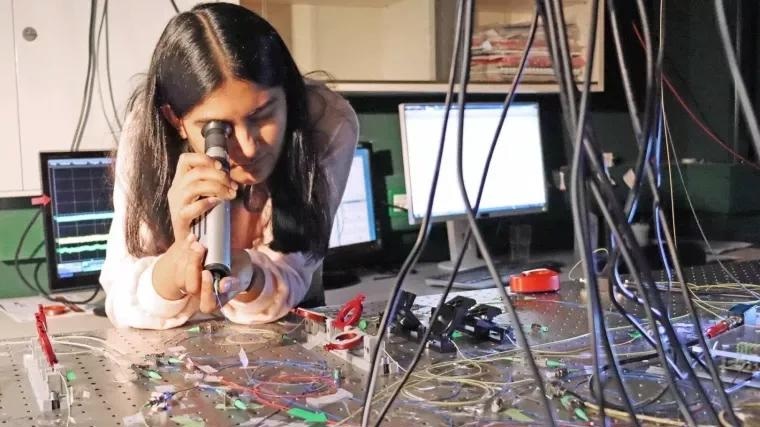Every day, massive volumes of data are transmitted, mostly as brief optical pulses traveling through glass fibers. When the density of such optical signals rises, so does their interaction, which can result in data loss.
 PhD student Monika Monika at the set-up where the experiments were conducted. Image Credit: Ira Winkler/Universität Jena
PhD student Monika Monika at the set-up where the experiments were conducted. Image Credit: Ira Winkler/Universität Jena
Physicists from Friedrich Schiller University Jena and the College of Optics and Photonics in Orlando, Florida, are exploring methods to accurately control vast numbers of optical pulses to limit the influence of such interactions.
They observed an ensemble of optical pulses as they moved across an optical fiber to this end and discovered that it follows certain principles, namely those of thermodynamics.
The team led by Prof. Dr. Ulf Peschel has reported a sequence of pulses that pass-through glass fibers that are only a few microns thin in the issue of the prestigious journal Science published on 10th March 2023.
Surprising Results
The results astonished the researchers.
We have found that the light pulses organize themselves after about a hundred kilometers and then behave more like molecules of a conventional gas, such as air, for example.
Ulf Peschel, Professor and Group Head, Friedrich Schiller University Jena
Particles in a gas move at varying speeds, but they all have a mean velocity specified by their temperature. Although light pulses travel at an average speed of around 200,000 kilometers per second through glass fiber, they are not all equally fast.
Peschel added, “The statistical distribution of their velocities equals exactly that of a conventional gas with a fixed temperature.”
This photon gas, as the researchers have now illustrated for the first time in their latest study, can be cooled, for example, by a process known as adiabatic expansion.
The particle velocity differences reduce while cooling, much like in a real gas, and the order in the signal sequence naturally rises. All pulses propagate at the same velocity when the absolute temperature zero of 0 Kelvin is attained.
Infinite Temperature
The process can also be reversed.
“When the optical gas is heated, velocity differences increase. If all pulse velocities occur equally frequently, the disorder is maximal and the temperature is infinite—a condition that cannot be attained in a real gas since an endless amount of energy would be required,” Peschel further stated.
A periodic modulation of the refractive index, on the other hand, might limit the range of allowed pulse velocities in the glass fiber. In this manner, all the available velocity states can be equally stimulated, resulting in a photon gas of unlimited temperature.
When more energy is supplied, states with extreme velocities are preferentially populated, and the photon gas becomes hotter than infinitely hot.
Peschel continued, “For this state, which has so far only been described theoretically for light, a temperature below absolute zero is mathematically assumed.”
He and his colleagues have now created such a photon gas with negative temperature and demonstrated for the first time that it abides by conventional thermodynamic principles.
Peschel concluded, “Our results will contribute to a better understanding of the collective behavior of large ensembles of optical signals. If we take the laws of thermodynamics into account, we can make optical data transmission more robust and reliable, for example by structuring pulse distributions to better match thermal distributions.”
Journal Reference:
Muniz, A. L. M., et al. (2023) Observation of photon-photon thermodynamic processes under negative optical temperature conditions. Science. doi:10.1126/science.ade6523